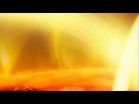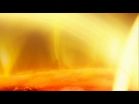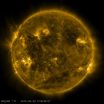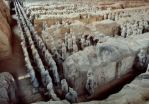(Press-News.org) VIDEO:
NASA's EUNIS sounding rocket mission spotted evidence to explain why the sun's atmosphere is so much hotter than its surface.
Click here for more information.
Scientists have recently gathered some of the strongest evidence to date to explain what makes the sun's outer atmosphere so much hotter than its surface. The new observations of the small-scale extremely hot temperatures are consistent with only one current theory: something called nanoflares – a constant peppering of impulsive bursts of heating, none of which can be individually detected -- provide the mysterious extra heat
What's even more surprising is these new observations come from just six minutes worth of data from one of NASA's least expensive type of missions, a sounding rocket. The EUNIS mission, short for Extreme Ultraviolet Normal Incidence Spectrograph, launched on April 23, 2013, gathering a new snapshot of data every 1.3 seconds to track the properties of material over a wide range of temperatures in the complex solar atmosphere.
The sun's visible surface, called the photosphere, is some 6,000 Kelvins, while the corona regularly reaches temperatures which are 300 times as hot.
"That's a bit of a puzzle," said Jeff Brosius, a space scientist at Catholic University in Washington, D.C., and NASA's Goddard Space Flight Center in Greenbelt, Maryland. "Things usually get cooler farther away from a hot source. When you're roasting a marshmallow you move it closer to the fire to cook it, not farther away."
Brosius is the first author of a paper on these results appearing in the Aug. 1, 2014, edition of The Astrophysical Journal.
Several theories have been offered for how the magnetic energy coursing through the corona is converted into the heat that raises the temperature. Different theories make different predictions about what kind of – and what temperature – material might be observable, but few observations have high enough resolution over a large enough area to distinguish between these predictions.
The EUNIS rocket, however, was equipped with a very sensitive version of an instrument called a spectrograph. Spectrographs gather information about how much material is present at a given temperature, by recording different wavelengths of light. To observe the extreme ultraviolet wavelengths necessary to distinguish between various coronal heating theories, such an instrument can only work properly in space, above the atmosphere surrounding Earth that blocks that ultraviolet light. So EUNIS flew up nearly 200 miles above the ground aboard a sounding rocket, a type of NASA mission that flies for only 15 minutes or so, and gathered about six minutes worth of observations from above the planet's air.
During its flight, EUNIS scanned a pre-determined region on the sun known to be magnetically complex, a so-called active region, which can often be the source of larger flares and coronal mass ejections. As light from the region streamed into its spectrograph, the instrument separated the light into its various wavelengths. Instead of producing a typical image of the sun, the wavelengths with larger amounts of light are each represented by a vertical line called an emission line. Each emission line, in turn, represents material at a unique temperature on the sun. Further analysis can identify the density and movement of the material as well.
The EUNIS spectrograph was tuned into a range of wavelengths useful for spotting material at temperatures of 10 million Kelvin – temperatures that are a signature of nanoflares. Scientists have hypothesized that a myriad of nanoflares could heat up solar material in the atmosphere to temperatures of up to 10 million Kelvins. This material would cool very rapidly, producing ample solar material at the 1 to 3 million degrees regularly seen in the corona.
However, the faint presence of that extremely hot material should remain. Looking over their six minutes of data, the EUNIS team spotted a wavelength of light corresponding to that 10 million degree material. To spot this faint emission line was a triumph of the EUNIS instrument's resolution. The spectrograph was able to clearly and unambiguously distinguish the observations representing the extremely hot material.
"The fact that we were able to resolve this emission line so clearly from its neighbors is what makes spectroscopists like me stay awake at night with excitement," said Brosius. "This weak line observed over such a large fraction of an active region really gives us the strongest evidence yet for the presence of nanoflares."
There are a variety of theories for what mechanisms power these impulsive bursts of heat, the nanoflares. Moreover, other explanations have been offered for what is heating the corona. Scientists will continue to explore these ideas further, gathering additional observations as their tools and instruments improve. However, no other theory predicts material of this temperature in the corona, so this is a strong piece of evidence in favor of the nanoflare theory.
"This is a real smoking gun for nanoflares," said Adrian Daw, the current principal investigator for EUNIS at Goddard. "And it shows that these smaller, less expensive sounding rockets can produce truly robust science."
In addition to having a lower cost, sounding rockets offer a valuable test bed for new technology that may subsequently be flown on longer-term space missions. Another advantage of sounding rockets is that the instruments parachute back to the ground so they can be recovered and re-used. The EUNIS mission will be re-tuned to focus on a different set of solar wavelengths – ones that can also spot the extremely high temperature material representative of nanoflares -- and fly again sometime in 2016.
EUNIS was supported through NASA's Sounding Rocket Program at the Goddard Space Flight Center's Wallops Flight Facility in Virginia. NASA's Heliophysics Division manages the sounding rocket program. EUNIS launched from the White Sands Missile Range in New Mexico. At the time of flight, the principal investigator for EUNIS was Doug Rabin at Goddard.
INFORMATION:
Best evidence yet for coronal heating theory detected by NASA sounding rocket
2014-08-01
ELSE PRESS RELEASES FROM THIS DATE:
Scientists solve 2,000-year-old mystery of the binding media in China's polychrome Terracotta Army
2014-08-01
Even as he conquered rival kingdoms to create the first united Chinese empire in 221 B.C., China's First Emperor Qin Shihuang ordered the building of a glorious underground palace complex, mirroring his imperial capital near present-day Xi'an, that would last for an eternity.
To protect his underworld palaces, the First Emperor issued instructions that his imperial guard be replicated, down to the finest details, in red-brown terracotta clay, poised to do battle. Thousands of these imperial guards were initially discovered in 1974; some contained patches of pigment that ...
Advances in assisted reproduction create more options and new legal issues for LGBT couples
2014-08-01
New Rochelle, NY, August 1, 2014—Lesbian, gay, bisexual, and transgender individuals who want to conceive a child may face the same problems as some of their heterosexual and cisgendered peers, such as reduced fertility, but in addition they often face additional physiological and legal challenges to become parents. A comprehensive review of the most recent advances in assisted reproduction options is presented in the article "LGBT Assisted Reproduction: Current Practice and Future Possibilities," published in LGBT Health, a peer-reviewed journal from Mary Ann Liebert, ...
On-chip topological light
2014-08-01
Topological transport of light is the photonic analog of topological electron flow in certain semiconductors. In the electron case, the current flows around the edge of the material but not through the bulk. It is "topological" in that even if electrons encounter impurities in the material the electrons will continue to flow without losing energy.
In the photonic equivalent, light flows not through and around a regular material but in a meta-material consisting of an array of tiny glass loops fabricated on a silicon substrate. If the loops are engineered just right, ...
Expressive writing may help breast cancer survivors
2014-08-01
Writing down fears, emotions and the benefits of a cancer diagnosis may improve health outcomes for Asian-American breast cancer survivors, according to a study conducted by a researcher at the University of Houston (UH).
"The key to developing an expressive writing intervention is the writing instruction. Otherwise, writing is just like a journal recording facts and events. Writing a journal can be therapeutic, but oftentimes we don't get the empirical evidence to determine whether it's effective or not," said Qian Lu, assistant professor and director of the Culture ...
Mapping the optimal route between two quantum states
2014-08-01
As a quantum state collapses from a quantum superposition to a classical state or a different superposition, it will follow a path known as a quantum trajectory. For each start and end state there is an optimal or "most likely" path, but it is not as easy to predict the path or track it experimentally as a straight-line between two points would be in our everyday, classical world.
In a new paper featured on the July 30 cover of Nature, scientists from the Institute for Quantum Studies at Chapman University, the University of Rochester, University of California at Berkeley, ...
Cordilleran terrane collage
2014-08-01
Boulder, Colo., USA - In the August 2014 issue of LITHOSPHERE, Steve Israel of the Yukon Geological Survey and colleagues provide conclusions regarding the North American Cordillera that they say "are provocative in that they blur the definition of tectonic terranes, showing that many observations of early geologists can be attributed to evolving geologic processes rather than disparate geologic histories."
Western North America is characterized by the Cordilleran accretionary mountain belt, which has seen episodic plate convergence since the early Paleozoic, about 253 ...
On-chipt topological light
2014-08-01
Topological transport of light is the photonic analog of topological electron flow in certain semiconductors. In the electron case, the current flows around the edge of the material but not through the bulk. It is "topological" in that even if electrons encounter impurities in the material the electrons will continue to flow without losing energy.
In the photonic equivalent, light flows not through and around a regular material but in a meta-material consisting of an array of tiny glass loops fabricated on a silicon substrate. If the loops are engineered just right, ...
Society bloomed with gentler personalities and more feminine faces
2014-08-01
DURHAM, N.C. -- Modern humans appear in the fossil record about 200,000 years ago, but it was only about 50,000 years ago that making art and advanced tools became widespread.
A new study appearing Aug. 1 in the journal Current Anthropology finds that human skulls changed in ways that indicate a lowering of testosterone levels at around the same time that culture was blossoming.
"The modern human behaviors of technological innovation, making art and rapid cultural exchange probably came at the same time that we developed a more cooperative temperament," said lead author ...
History of culture visualized through art history, physics, complexity
2014-08-01
Coral Gables, Fla. (July 31, 2014) -- Quantifying and transforming the history of culture into visual representation isn't easy. There are thousands of individual stories, across thousands of years, to consider, and some historical conditions are nearly impossible to measure.
Addressing this challenge, Dr. Maximilian Schich, associate professor of arts and technology at The University of Texas at Dallas, brought together a team of network and complexity scientists, including University of Miami physicist Chaoming Song, to create and quantify a big picture of European ...
'Normal' bacteria vital for keeping intestinal lining intact
2014-08-01
August 1, 2014 — (BRONX, NY) — Scientists at Albert Einstein College of Medicine of Yeshiva University have found that bacteria that aid in digestion help keep the intestinal lining intact. The findings, reported online in the journal Immunity, could yield new therapies for inflammatory bowel disease (IBD) and a wide range of other disorders.
The research involved the intestinal microbiome, which contains some 100 trillion bacteria. The role of these microorganisms in promoting or preventing disease is a major emerging field of study. Einstein scientists found that absorption ...











